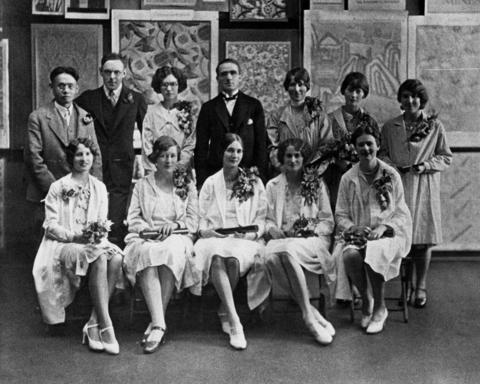
In 1929 Virginia Woolf published her essay, “A Room of One’s Own”, based on lectures she had given the previous year at Cambridge University. In it, Woolf made her famous observation that “a woman must have money and a room of her own if she is to write fiction.”
I doubt that the essay was widely known in Vancouver. Even so there was a group of young local women who knew the truth of its central message from personal experience. They were among the first graduates of the art school, founded four years earlier in the offices of the Board of Education at the corner of Dunsmuir and Hamilton streets.
The photo above (Vancouver Archives 363-2) shows the school’s inaugural graduating class in 1929. That’s director Charles Scott in the back row centre. Otherwise you can see that almost all the grads were women. (Interestingly, the woman seated front row centre is Beatrice Lennie, noted sculptor and my wife’s high school art teacher.) Once they had finished at the school several of these women rented studios in a large house in the West End called Parakanthas. (No one seems to know the meaning of the name.) Unhappily the house has been torn down and replaced by
But for a few years 1929-34 Parakanthas provided space for young artists to pursue their work.
Women in the inter-war period struggled to find the time and the recognition to make a career in the arts, whether writing or the visual arts. This was true in Vancouver no less than Virginia Woolf's London, or anywhere else. Jack Shadbolt, who attended the art school in the 1930s, dismissed the female students as dilettantes, “daughters of the better-off merchant families." Contemporary society assumed that young women would marry and devote themselves to raising a family. Jobs outside the home were scarce, as was time to pursue their own ambitions. Even for women from well-to-do backgrounds, their work was not taken seriously. They could not rely on support from patrons or critics. They had to carve out a place for themselves and find their own resources to make their own futures.
And that was the point of Parakanthas. Although men were allowed -- Fred Varley also had a studio there -- it was a remarkable and unprecedented community of female artists finding rooms of their own.